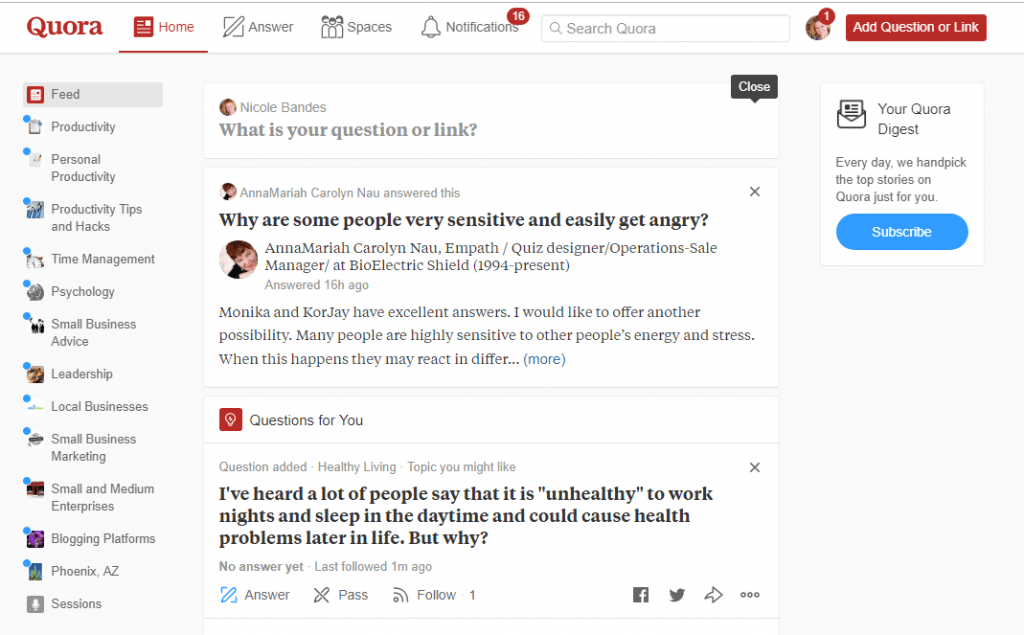
Staff Writer
You must have heard that you need to create unique content for your blog often, right? Whether you are an unwilling or a natural blogger, it’s important to maximize blog content to make the most of every post's visibility.
Here’s an all too familiar scenario:
You finish writing engaging content for your blog and you joyfully post it on your site. You then promote it on your social media accounts - once…
Next, you question why it's not generating leads and traffic. No comments, no engagements. Nada!
There's nothing like that sinking feeling when you've put a lot of hard work into a blog and no one sees it.

“What is it that I'm not doing? Is it the article? Why is no one interested? "Do I need to change the approach?” Well, maybe.
Why Your Blog Content Isn't Generating Leads
Many bloggers stop putting in any effort to promote their content after they publish an article. They tend to wonder why no one visits the blog or hit the share button. Maximizing blog content by promoting it across different social media sounds difficult. But if you and your team put it in the work and add it to the routine, it'll be worth the effort.
Download our Ultimate Guide to Delegating for More Tips & Tools on How to Delegate as a Solopreneur
Leading your social audience back to your blog can work magic. You need to create quality content for your blog, do keyword research and draft a social sharing strategy. Hold on...we don't mean to overwhelm you. We understand that it’s a complicated process. But it works. And it isn't so bad when you have a team.
10 Steps to Maximize Blog Content and Boost Traffic
When it's time to maximize blog content, work smarter, not harder. No worries, we are with you - here are 10 steps you can take to maximize blog content and boost blog traffic!
1. Create Great Content for Your Blog
If we want to boost blog traffic, we must create quality content. You may have heard the term “content is king.” In actuality, it's thrown around more than a baseball in a ball game. But do you know that creating quality content isn’t only about quality? It includes developing content marketing strategies.
Good content satisfies a particular need. Consider your audience and find out what they love. Presently, articles fall into these categories: Useful and informative or modern and funny. Pick one, and you’ve laid a foundation.

Smart Tip: Mental block? No problem. Check Quora to know the questions asked, which relate to your business subject. Also, Buzzsumo contains contents written by others in your industry. Go through them as they'll help you can craft better contents. We've also discovered that these blog topic generators are useful.
In terms of style, aim for mind-boggling statistics, superb storytelling through video, and appealing infographics. In essence, create stuff your audience will want to click and share.
Want to learn how videos can help market your business? Click here
Create Evergreen Content for Your Blog
Evergreen contents? Yes, evergreen! Evergreen contents are timeless. It's a great way to maximize blog content by generating traffic that keeps coming.
For instance, an article about this year’s Easter event will become irrelevant later. But an article about the pros and cons of something, the history of something, or statistics will remain relevant, making it evergreen.
So let's make certain that most of our contents are evergreen. For evergreen content ideas, click here.
Create Awesome Headlines
It's about time we started creating compelling headlines. The internet is full of junk, let's not add more, a great headline is what captures the interest of visitors.
Truthfully, a headline is more powerful than the main post! If engaging content hides behind a poor headline, it won't survive. Appearance is key.
Can you show up at a party wearing an apron or a sick cloth? I guess not. It applies to content too. We shouldn't rely on dull headlines to improve our blog posts.
Try to test many headlines. Share your blog content many times with different headlines to select the best style.
Do you want more blog traffic? Read: Blog management, Read up why you should hire a VA.
Start a Newsletter to Display Quality Articles
Do you know what needs a large part of our content strategy? Promotion! If you're wondering why? Well, we need it so our articles can drive traffic to our site!
An easy way to maximize blog content and begin directing traffic to your site is to send emails for a blog newsletter. After collecting those contacts, send them emails monthly or weekly.
We recommend that you include a link to your recent blog post below your email signature. Try WiseStamp. Set it up one time, and it will update through RSS feed.
Pro Tip
Feature your best articles in your newsletter, bringing frequent visitors right back to the site. After all, these visitors are comfortable with your blog already. They might explore a lot more when they revisit the website.
2. Use Keywords
Want to drive massive traffic to your site? Make Search Engine Optimization (SEO) and keywords a big part of your strategy. People get nervous when we suggest the use of Keywords and SEO, but remember this; SEO works when it’s done right. In other words, you’ll get real traffic from Google. Additionally, your users get the information they’re looking for.
So do you know what to do now? No? Shout, “I'll always value keywords” and shout it out loud! But remember to use keywords in moderation.
DOs
- Add keywords in your content
- Include links to other articles you’ve written, especially related articles.
- Allow keywords to guide your outline and help envision your articles
DON'Ts
- Don't stuff your content with keywords to saturate them entirely with search queries
- Avoid adding a lot of links so that every other sentence is marked with blue hyperlinks.
- Don't put search bots and keywords before user experience.
Google drives many searches daily. You need keywords to rank on the result page.
With many advertisers and websites online, and competing for the successful keywords, do you stand a chance? Yes. How?
Wait for it....
Long Tailed Keywords Explained:
These keywords are search phrases with more than three keywords. It's simpler to target long-tail keywords since the struggle for these phrases is less. Using long-tail keywords can help us get a top Search Engine Results Pages (SERP) spot on Google.
If you’d want to rank high in Google for “exercise gadgets”, you need long tail keywords. “Exercise gadgets” is a competitive phrase.
But, if you concentrate on “affordable exercise gadgets” or “exercise gadgets for running,” you'll rank higher.
Now how do we conceive these excellent long-tail keywords? Begin with Google. Start writing in a phrase on Google and see what its auto-complete suggestions are.
Next, put some of the auto-complete suggestions into Google to get few related search suggestions. They're positioned towards the end of the page.
Are you done with that? If yes, take every long-tail phrase you want and input them in the Google Keyword Planner.
Get the phrases that push the most traffic and extract the keywords with low competition and high search volume. Voila! You've gotten your long-tail keywords! Next, we suggest creating content around those keywords.
Pro Tip
Don't ignore the other keywords Google suggests. They might be your golden keywords.
3. Find Your Audience
If we want to drive more traffic and maximize blog content, we need to go where our target audience hangs out. Knowing your audience can help you build excellent referral links from reputable websites.
Use Google Analytics to determine the sites pushing the most traffic. Look for the sites and forums your audience frequents, and get active.
Discuss topics, comment on blogs and post links when suitable. Don't pass as spammy. Let them see you as an essential member who brings in vital information.
If a member needs advice about weekly exercise plans, point them to your website! If it's something unrelated to your business, you can move along.
The moment you find your audience, go all in.
If you need more traffic, you can ask. A study shows that people who requested their followers to retweet their posts on Twitter get 73.48 average retweets. People who didn’t ask only got 2.09 retweets.
If you want users to share your post, all you need to do is ask! It's that simple.
4. Optimize for Mobile and Speed
Viewers won't wait around for your site to load. If your page doesn't load up fast enough, they’ll try the next or even a competitor’s site. Remember, time waits for no one.
If you want to check the speed of your site, Google’s Page Speed Insights tool (link) will help. It gives the speed score and tips on what to do to give your website what it needs to improve.
Likewise, users spend about 3 hours a day on a mobile device or tablets (link). Going mobile is an easy task for website owners. If your current blog isn't sufficiently good, explore any of these Wordpress plugins. They help build a better style of your blog that's optimized for tablets mobile phones.
5. Establish Good Relationships with Other Bloggers
If you want to build traffic online, good habits can go a long way. We recommend building solid ties with other bloggers in your field. Teaming up with your competition is a good strategy. If you've seen Game of Thrones, then you know what I mean.
Stay active in different forums and comment on other blogs. Think about interviewing key industry bloggers or add other bloggers in a “Top 5 or Top 10” post style. For instance, Top 5 Blogs for health and lifestyle.
Once you feature or cite a blogger in any posts, tag them in your social media to let them know. They'll likely share or retweet the post mentioning them. This act will give you more shares and of course, more traffic in turn.
6. Include Interlinks
Yes, linking to your site is right for SEO. But it’s vital to link to other sources too. This shows that you’re not a spammer. It also tells Google that you're helping to build a real relationship with other websites you’re linking to.
Also, links within your articles to other sections of your site, using keywords, inspire visitors to explore. Note that you’re building an experience for readers and adding value.
If there’s an article written from another website that can add value, link to it. Yes, if your audience knows that you're a source for relevant content, they’ll come to you for more.
7. Use Videos
Do you want to add a little pizzazz to your blog post? If so, we recommend using video. Combining written content with videos can distinguish you from your competitors.
Further, articles with videos create more inbound links and boost viewership than a content without.
8. Include a Call to Action (CTA)
“A call-to-action or CTA is a line of text or image that (prompts your consumers, leads, and visitors to take action.
We advise that you include a CTA at the end of a Google+ post, Facebook post, blog post or any anywhere you want the audience to take action.
Although your aim may appear clear to you, restating the course of action for audiences raises the plausibility that they’ll follow through.
9. Share New Contents on Social Media Accounts
![]()
Establish a schedule that you're comfortable with. For example, you can post more often on Facebook than on Twitter, and you won't lose your audience. Consider what works better on each platform. Learn the best social media for business here.
10. Incite Subscriptions and Comments
Encourage visitors to comment, and reply to the comments in a meaningful. Interaction builds rapport—and offers opportunities to add engagement, long-tail keywords, and new content for your blog. One strategy to encourage comments is to conclude blog posts with a call to respond.
We recommend adding visible buttons for subscribing via email. Subscribers will have access to your blog without visiting it.
Final Thoughts
We shouldn't let our contents to wither in the back of beyond. Follow these rules and watch how your traffic will soar to your website in no time!
Get more content like this on our website or click the following related articles below:
Why You Need to Have a Target Audience and How to Find One
Why your Newsletter Opt-in needs one
Don't stop now! You'll also love this other great content...



